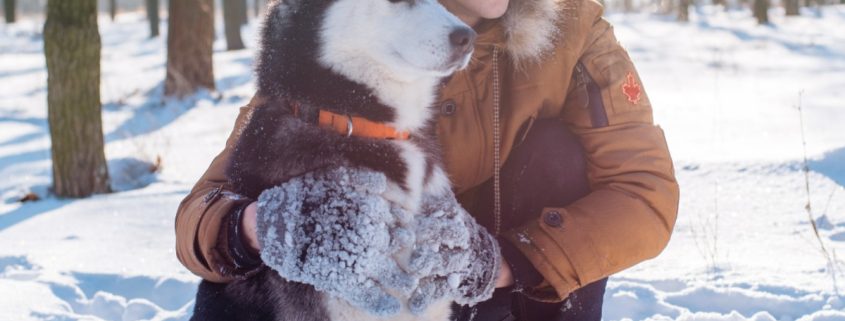Aside from mealtime, going for a walk is the best part of your dog’s day. But now that winter has set in across the country—with many areas experiencing record-breaking cold temperatures—it is important to understand just the amount of cold your dog can actually tolerate. While their fur does insulate them, every dog has a limit to how long they can safely be exposed to cold, and it varies from dog to dog based on size, breed, age, and health status.
That said, don’t let the cold keep you locked indoors until spring! Daily walks and outdoor playtime are essential to your dog’s mental wellbeing and physical condition. A dog that is exercised regularly will behave better, sleep better, and is more likely to maintain a healthy body weight. Some basic knowledge of the safe temperature range for walking your dog is all it takes to plan for walks on nicer days and indoor play sessions when it’s too cold to be outside.
So, How Cold Is Too Cold?
The chart below is based on a scale created by Tufts University that factors in a dog’s body condition and the outdoor temperature. You can reference this chart as a general guideline for knowing at what temperature it is safe to walk an adult dog that is at a healthy body weight:
One caveat to this chart is that it does not account for wind chill. A 30° Fahrenheit day with no wind will feel much warmer than a 30° Fahrenheit day with a steady 30 MPH wind. You should always factor in windchill and use the “feels like” temperature when consulting this chart.
Likewise, precipitation can impact your pet’s safety during winter walks. If heavy, wet snow is falling, your pet will begin to lose body heat as they become wet. Shorter, more frequent walks may be in order on a day when snow or sleet are in the forecast.
Finally, your dog’s age, breed and health are major factors to consider. Puppies and senior dogs can be more sensitive to cold because their bodies may have difficulty regulating temperature. Short-haired breeds get cold quickly and should be dressed in a coat or sweater for walks. The cold can also be hard on dogs with physical limitations such as joint issues or overweight dogs. For all of these dogs, keep walks short if the temperature is below freezing and take them out for potty breaks only in subzero weather.
Cold-Weather Safety Tips
Slips, Falls & More: While dogs love nothing more than running and frolicking in the snow, there are a number of dangers to be mindful of. Besides slipping and falling, our excitable canines could unwittingly run onto frozen bodies of water and risk falling through ice. For this reason, it’s always best to keep dogs on a leash while trekking through snowy terrain.
Sticking to cleared paths makes sense but chemical salt used to melt ice on pavement can irritate your dog’s skin and may burn their paws with prolonged contact. A pair of water-resistant dog boots are the best winter walking defense, but if your pup prefers to go barefoot, be sure to rinse their paws as soon as you return home to remove harmful chemicals. Spilled antifreeze in driveways and parking lots is also a danger, as it has a sweet taste that can attract pups and can be fatal if ingested.
Staying Warm Inside & Out: While some dog breeds (such as Alaskan Malamutes, Huskies, and Saint Bernards) are well-suited to outdoor play in the cold without protective gear, many dogs will be safer and more comfortable with a coat or sweater and possibly some protective boots. Small dogs, short-haired breeds, puppies, seniors and dogs with health concerns should be bundled up before venturing outside in winter. If the weather is cool but dry, a warm sweater is a good choice. However, if it’s raining or snowing, a raincoat or water-resistant coat is preferable.
Although it may be tempting to let your pooch munch and crunch on snow, this could be dangerous for their health. Eating a large volume of snow can lower body temperature and may cause hypothermia. Instead, take along a container of water for them to drink so they’re not tempted to chow down on the white stuff. Also, it is impossible to see what is under the snow, which puts your dog at risk of ingesting a foreign object or harmful chemicals or being injured by a sharp object.
Finally, most dogs know when they have had enough of the cold and will give you cues they are ready to go in and warm up. (Although some heartier breeds may need you to tell them it’s time to go in.) Pay attention to your dog’s body language; if they start to whine, alternate holding one paw up off the ground, or shiver excessively, they’re telling you they are ready to go inside and curl up in a cozy spot!
Your Pets are our Priority!
At the National Animal Supplement Council (NASC), our number one priority is to promote the health and wellbeing of your pets. That is why we created the NASC Audit Program and the Quality Seal, which helps you identify animal health and nutritional supplements that come from responsible suppliers committed to producing the highest quality, most consistent products available. Visit our website to learn more and to see a list of NASC members that have earned the Quality Seal.


